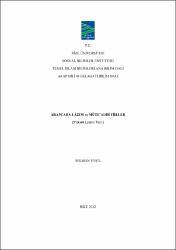| dc.description.abstract | Arapçada mütekellim ve muhâtab arasındaki iletişimi sağlayan cümle, kelimelerden oluşur. Kelime, harflerden oluşan ve manâ ifade eden sözcüktür. Kelime ifade ettiği anlamlara bağlı olarak isim, fiil ve harf olmak üzere üç kısma ayrılır.Kelimenin üç kısmından biri olan fiil, çeşitli açılardan kısımlara ayrılır. Bu kısımlardan biri de mef'ûlün bih alıp almamasına bağlı olarak ortaya çıkan lâzım ve müte'addî fiil kısımlarıdır.Lâzım fiil, mef'ûle etki etmeyen fiillerdir. Müte'addî fiil ise, mef'ûle etki eden fiildir.Müte'addî fiillerin tümü aynı sayıda mef'ûl almamaktadır. Müte'addî fiil de aldığı mef'ûl sayısına göre bir mef'ûl alan fiiller, iki mef'ûl alan fiiller üç mef'ûl alan fiiller olmak üzere üç kısma ayrılır. Lâzım fiil ise, sürekli lâzım, bazen lâzım bazen müte'addî olmak üzere iki kısma ayrılır.Lâzım ve müte'addî fiiller, ifade zenginliği için birtakım kurallar dâhilinde birbirine dönüştürülebilir. Böylece daha akıcı ve üslup açısından daha zengin ifade tarzları elde edilebilir. In Arabic, the sentence providing the communication between the speaker and the receiver consists of words. Word is an expression which consists of letters and has a meaning. It is divided into three parts as noun, verb and adverb, depending on the meaning it conveys.Verb, one of three parts of word, is divided into some parts in some respects. Of these parts are intransitive and transitive verbs depending on the fact that whether the verb is followed by an object or not.Intransitive verb are the parts which have no effect on the object. Transitive verbs, however, are those which have effect on the object.All the transitive verbs are not followed by the same number of objects. Depending on the guantity of the objects, transitive verbs are also divided into three parts as the transitive followed by one object, he transitive followed by two objects and the transitive followed by three objects. Intransitive verb is divided into two parts as continous intransitive, occasionally intransitive and occasionally transitive.Intransitive and transitive verbs, on account of richness in expression, can be transformed into one another through certain rules. Thus, more fluent and rich stlyistic expressions can be formed. | en_US |


















